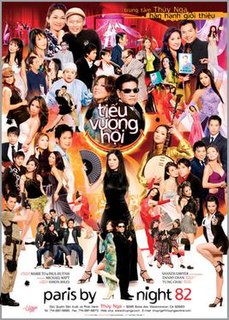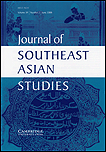Dương Triệu Vũpronunciation (help·info)(born January 1, 1984 in Cam Ranh, Vietnam) is the stage name of Tuấn Linh, a singer on the popular Vietnamese diaspora music show Paris By Night.

Paris By Night 82: Tiếu Vương Hội is a Paris By Night program that was filmed at Studio 40 of the Canadian Broadcasting Centre in Toronto, Canada on Saturday, March 25, 2006. It is one of Thúy Nga's "private" shows, as in, limited seats are available, and some are only invited guests only.

Lệ Thủy is a district of Quảng Bình Province in the North Central Coast of Vietnam. The district borders Quảng Ninh District on the north, Vĩnh Linh District on the south, Laos on the west. Lệ Thủy central is 40 km south of the provincial capital Đồng Hới. The district government seat is Kiến Giang Township. The district area is 1420.52 km2, population: 140,804 (1998). Lệ Thủy District is home to Võ Nguyên Giáp and the family of Ngô Đình Diệm. Economy bases on agriculture, mainly rice culture. Mỹ Trạch massacre by French army happened here on 29 November 1947.
The Trần Cao rebellion in 1516 is the best documented rebellion in the Eastern of Đại Việt, another name for Việt Nam in the 16th century against the Lê dynasty led by Trần Cao and is regarded as the most important. It was the second rebellion led against the Le, following an uprising led by Trần Tuân in 1511.

Paris By Night 89: In Korea is a Paris By Night program that was filmed at the Olympic Fencing Gymnasium at the Olympic Park in Seoul, South Korea on Sunday, July 1, 2007. It is Thúy Nga's first venture into Asia to tape a Paris By Night program. Thúy Nga chose to tape at South Korea, rather than any other country in Asia simply because of the popularity of Korean actors and singers to the Vietnamese community. The program is directed by a Korean director, Seounghyun Oh. It is Thúy Nga's fourth "Live" show.

Paris By Night 92: Nhạc Yêu Cầu was filmed on May 10, 2008 and May 11, 2008 at Knott's Berry Farm, California. In an attempt to make the programs more diverse, Thúy Nga had encouraged the fans to send in their requests in the format of video clips. The requested songs can be done by an individual or a group of people.

Paris By Night 91: Huế, Sài Gòn, Hà Nội is a Paris By Night program produced by Thúy Nga that was filmed at the Terrace Theater at the Long Beach Convention and Entertainment Center on January 12, 2008 and January 13, 2008.

Paris By Night 79: Dreams is a Paris By Night program produced by Thúy Nga that was filmed at the San Jose Center for the Performing Arts, on August 20, 2005. The show was MC'ed by Nguyễn Ngọc Ngạn and Nguyễn Cao Kỳ Duyên.

Paris By Night 78: Đường Xưa is a Paris By Night program produced by Thúy Nga that was filmed at the Canadian Broadcasting Centre Studio #40 in Toronto, Canada on June 11, 2005. The MC's were Nguyễn Ngọc Ngạn and Nguyễn Cao Kỳ Duyên. Seats are limited to a studio audience and is considered a private event.
Below is a list of Vietnamese exonyms for various cities and countries around the world. The list does not include Vietnamese-speaking areas and cities, including Vietnam itself. Cities in bold are the capital cities of their respective country. The Vietnamese exonym is after the name of the city in English. An asterisk [*] indicates a name that is still in common use. For the other countries or cities, Vietnamese people usually use the English names.

Paris by Night 98: Fly With Us to Las Vegas is a Paris by Night program produced by Thúy Nga that was filmed at the Theatre for the Performing Arts in Planet Hollywood Resort & Casino and had a DVD release on December 10, 2009. The show was hosted by Nguyễn Ngọc Ngạn and Nguyễn Cao Kỳ Duyên.

Paris By Night 100: Ghi Nhớ Một Chặng Đường is a Paris By Night program produced by Thúy Nga Productions that was filmed at the Planet Hollywood Theatre for the Performing Arts in Planet Hollywood Resort & Casino on July 3 & 4, 2010 and released DVD on October 7, 2010. The show was hosted by emcees Nguyễn Ngọc Ngạn and Nguyễn Cao Kỳ Duyên.

Paris By Night 99 – Tôi Là Người Việt Nam is a Paris By Night program produced by Thúy Nga Productions that was filmed at Knott's Berry Farm on 16 and 17 January 2010 and released DVD from 8 April 2010. The show was hosted by Nguyễn Ngọc Ngạn, Nguyễn Cao Kỳ Duyên and Trinh Hoi.

Mạc Phúc Nguyên, also known as Mạc Tuyên Tông (莫宣宗), was an emperor of Vietnam's Mạc dynasty who reigned from 1546 to 1561.
Cards on the Table is a 1980s Vietnamese 35mm black and white film directed by Lê Hoàng Hoa in his art name Khôi Nguyên.
Farewell Summer is a 1992 Vietnamese 35mm romance film adapted from Nguyễn Đông Thức's 1992 novel of the same name. The film was produced by Giaiphong Film Studio and directed by Lê Hoàng Hoa.














